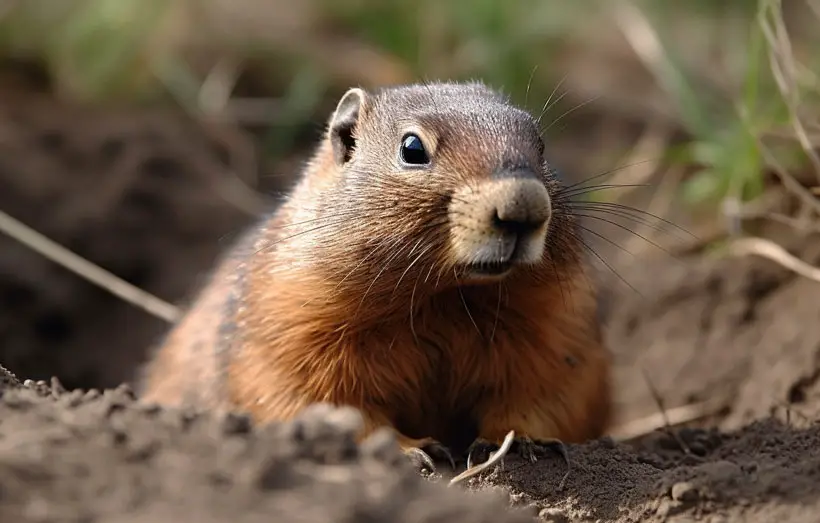Examining Can Gophers Have Rabies – Minimizing Health Risk
Gophers are familiar rodents to homeowners and gardeners for creating extensive tunnel systems underneath the soil, negatively impacting vegetable and crop production. And like other rodents, gophers also carry various harmful viruses and bacteria.
It is a crucial concern for human beings living in gopher-populated areas. With their huge population and strong presence in the lawns, gardens, and agricultural fields, many people feel threatened by the virus-carrying context.
Thus, the question arises, can gophers have rabies? Well, the answer is “yes.” Gophers carry the rabies virus, which can be transmitted to humans and other animals through their saliva.
However, there are a very small number of known cases showing rabies transmission from gophers to humans. Still, understanding the risks associated with gopher encounters and potential disease transmission is important for several reasons.
First, the respective contamination is a direct threat to humans and their pets. Second, understanding the risks associated with gophers also helps promote responsible and safe pest control methods, i.e., not causing any unnecessary harm.
In this article, we explore in detail the context of gophers carrying rabies to ensure the health and safety of yourself and your loved ones. At the same time, protecting the species from becoming extinct.
Gopher Behavior
Gophers are herbivorous and live in underground tunnels. They eat under-soil components of live plants. Let’s check out their behaviors and eating habits.

Behavioral Characteristics
You may find the following facts about this animal behavior in their burrowing and foraging habits:
- Gophers are also known as soil engineers. They are masters at creating tunnel nets to ensure safe passage within the other animals’ presence.
- The tunnels can be both shallow and deep and have multiple entrances and exits depending on the gopher’s needs and the soil type.
- The creation of soil mounds at the entrance and exit of the tunnels is also another core characteristic of gophers. One healthy gopher usually creates multiple soil sealings on the tunnel ends.
- Gophers are non-hibernating species, and they remain active throughout the year. Their activity increases during the early morning and late afternoon. And the rest of the time, they stay inside the tunnels, resting.
- They are solitary animals. Gopher species are very active in maintaining their territory within the tunnel system. However, this behavior gets reduced during the breeding seasons. This time they become tolerant toward other gophers.
- Finally, gophers are problematic for plantations, but they also play a crucial role in the ecosystem. These species help aerate the soil and distribute nutrients while supporting the inhabitance of deep-soil species like earthworms, etc.

Gophers are also a vital food source for many predators, like owls, snakes, foxes, etc.
Eating Habits
Below is a discussion about Gopher’s eating habits.
- Gophers are primarily herbivorous. They used to feed on a variety of vegetation, including roots, bulbs, tubers, and grasses. They search these foods by sensing the respective smell and reach the foods through the tunnel.
- The search for food drags gophers on the surface; its very less.
- Gophers may also occasionally eat insects and small animals, such as snails, earthworms, etc. These living components mostly share gophers’ tunnels; gophers do not need to chase them at all, easy target.
- Most importantly, gophers’ eating behavior also includes storing excess food in their burrows for later consumption.

Food Preference
Below is more detail about the plants that gophers like and dislike.
- In particular, gophers mostly like to eat plants with large taproots, such as carrots, onions, beets, etc.
- They also like to eat tubers like potatoes, sweet potatoes, etc.
- Some other top-favorite plants of gophers are alfalfa, clover, dandelions, etc. They are also fond of various types of grasses, such as mosquito grass, prairie Junegrass, Kentucky bluegrass, needle and thread grass, and scorching rush.
- However, there are a wide variety of plants that gophers do not like. Some must-mentions are castor bean, lavender, rosemary, catmint, oleander, daffodil bulbs, and certain types of euphorbia.
Risks of Gopher Encounters
In general, gophers are not typically aggressive toward humans. Still, like many other animals, they may bite or scratch if they feel threatened or cornered. Encountering a gopher can pose several potential risks. We categorized the associated risks into two segments: direct and indirect.

In consideration of direct risks, there is a moderate chance of disease transmission and experiencing infections. However, people with a weaker immune system face more vulnerabilities.
Again, in the case of indirect risks, a person with a degraded health condition can get infected through contact with virus-contaminated soils. Here, soil contamination occurs through gopher swarms, feces, or urine.
Possible Diseases
Below is a comprehensive list.
- People may face some serious respiratory issues due to the transmission of the Hantavirus from gophers to humans.
- Other possible animal diseases that humans can experience are fever, chills, joint pain, headache, inflamed eyes, sore throat, diarrhea, pneumonia, and other flu-like symptoms.

These are usually caused by the transmission of Tularemia, Leptospirosis, and Plague bacteria from gophers to humans.
- Rabies is also another viral-based disease that can be transmitted to humans by gophers. In this case, people usually experience symptoms like tiredness, headache, sore throat, and fever.
Minimizing the Risks Associated with Gopher Encounters
There are four prominent ways to minimize the risks associated with gopher encounters. Below are the details.
- While working in an area with gopher infestation, wearing gloves, long-sleeved shirts and pants, eye protection, etc., is essential.
- After dealing with soil that is contaminated with rodent droppings or other bodily fluids, washing hands with soap and water is essential.
- Controlling the gopher population effectively is another lucrative solution to minimizing the risks associated with gopher encounters.
- Humans, pets, and livestock can face health issues after encountering gophers. Hence, it is always better to keep them away from gopher burrows.
Rabies Risk
As mentioned earlier, gophers can transfer the rabies virus to humans. And gophers carrying rabies is not that surprising context. Many rodent-like species carry this virus.

Some must-mention animals are raccoons, skunks, foxes, and bats. Among these, raccoons are more vulnerable to spreading rabies to humans.
Transmission Process and Symptoms
Rabies is one of the prominent viral rodent diseases that usually affect the nervous systems of mammals, including humans. Its transmission process is very straightforward. It transmits from gophers to humans through Slavia.
If rabid gopher bites or scratches a human, the disease is transmitted. The virus can also be transmitted when contaminated saliva comes into contact with the open skin, eyes, nose, or mouth of a human.
How to Tell If a Gopher is Infected?
However, identifying wildlife-borne illnesses is critical for common people without adequate knowledge of rabies in animals. In general, a rabies-infected animal shows some behavioral changes like unusual aggressiveness, weakness in movement, paralysis, stiff muscles, etc.
Also, rabid animals used to have a foam-like substance on the corner portion of the jaw due to the additional amount of Slavia released. Finally, if you observe gophers with these symptoms in your area, do contact the local animal control agency and public health department.
They will take the necessary actions. Thus, an in-depth understanding of how gopher behavior and disease spreading are interrelated will assist you in action taking process.
Diseases Prevention
We have already suggested you wear protective measures while working in gopher-populated areas. Also, after seeing sick gophers, the actions taken by the local animal control agency and public health department are considered acts of prevention.

Yet you can become infected due to the rabies transmission from gophers and experience flu-like symptoms such as restlessness, headache, sore throat, fever, etc. In such cases, apply the below-listed approaches.
- Consult a physician as soon as possible. Inform the physician if you have observed any sickness in the respective gopher. Show the respective wound as well.
- Take post-exposure prophylaxis (PEP) treatment to restrict rabies contamination. It is a dose of human rabies immune globulin and rabies vaccine.
- Clean the wound promptly with soap and water and use disinfected ointments.
FAQs
Here we answer some of the most common questions.
Q: Can gophers carry rabies?
Yes. Gophers can carry the rabies virus and also several other disease-making microscopic elements, like Tularemia, Leptospirosis, and Plague bacteria. The rabies virus from gophers can be transmitted to other animals by their saliva, urine, feces, etc.
Q: How do I know if a gopher is infected with a disease?
Various signs can assist you in identifying zoonotic diseases‘ presence in gophers. The very first one is the deposition of a foam-like substance within the jaw.
Also, if you see a gopher moving more slowly than usual, lying down without any movement for a longer period, or showing stiffness in the muscle movement, surely that one is sick.
Last Words
We hope our answer to whether gophers have rabies will help you understand the consequences of encountering an infected gopher. By understanding the potential risks associated with gopher encounters, you can protect yourself from rabies and other associated diseases.
You should wear protective measures with working in the fields, restricting gopher bites, scratches, or exposed skin contact with the infected species Slavia. In addition, contact with soil contaminated by sick gophers’ Slavia, urine, or feces also can cause health issues.
We would like to signify these animal-human interactions understanding in terms of protecting people’s health and minimizing exposure to potential dangers. And it also assists people in making informed decisions about managing the gopher population and presence in the area.
Finally, we suggest our readers consult with a local wildlife monitoring agency and public health organizations to ensure the coexistence of humans and pests.
Also, having more research on this aspect and studying various scientific research papers helps handle the gopher encountering context more efficiently. That will make you aware of standard wildlife management practices.
However, another crucial available source of information about gopher control is local pest control companies.




